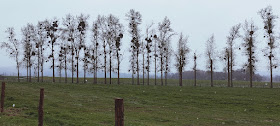In just a few days from now we will be once again loading ourselves onto a large ship which will carry us silently through the night to that distant world called Great Britain (or whatever name it now calls itself). From here we will squeeze ourselves onto the first of many crowded roads, remembering to cross to the left side, and motor northwards again to the place we call home. Having just spent the last three days driving northwards through France on nearly empty roads (thanks to Mrs Google); smoothly surfaced, long straight sections running away into the distance, slowing down for each village then accelerating once past the last house, it has occurred to us just how different the driving experience will be once we are back on British soil. We'll soon be back in the world of traffic queues and crowded roads - we are not looking forward to it - but then all good things must come to an end.
France is not all a bed of roses, of course, and if we had to name one place we are unlikely to revisit it is the town of Gray. And who could have thought of a better name! Straddling the River Saône this place has an air of failure about it, as if someone has tried to make it somewhere pleasant but not quite succeeded. An information board in the town centre is blank, as if to say 'nothing happens here'. Closed up shops are always indicative of someone's misery and there are plenty of these too.
Contrast this with a tiny village just to the north
where this grand beast stands proudly at the roadside glaring out at every passer by as a bold statement saying 'look at me!' Or even back in the Jura where we couldn't help but meet another giant beast sitting at the rear of a shop which sold...well, wooden things.As ever our mode of travel hasn't changed though. Mrs Google has instructions to avoid main roads, which she does faultlessly as she directs us across farmland then through woodland and every small village settlement she can find. What is remarkable, though, is that she now has a companion, un copain as they might say in France, a well spoken man's voice, who will add his own guidance tips whenever he feels they are needed, as if to say 'Just to clarify what Mrs G has said.... try turning left just up ahead'. There never seems to be any actual back chat between them and we speculate that he only butts in when Mrs G needs a comfort break. We don't have a name for him yet but I'm sure we'll find one soon enough. We like to take advantage of modern technology when it makes our lives easier but it is rather worrying when that same technology does things we have not asked for, harmless though it may be.
























 .
.












